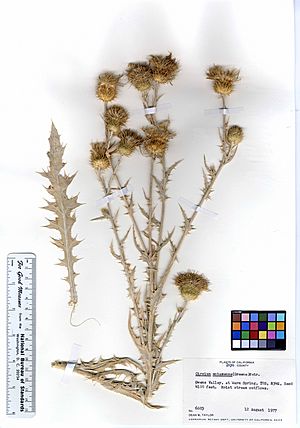Virgin thistle facts for kids
Quick facts for kids Virgin thistle |
|
|---|---|
 |
|
| photo of herbarium specimen at University of California @ Davis, collected in Owens Valley, California | |
| Scientific classification | |
| Genus: |
Cirsium
|
| Species: |
mohavense
|
| Synonyms | |
|
|
Cirsium mohavense is a type of thistle plant. People often call it the virgin thistle or Mojave thistle. It grows naturally in the southwestern United States. You can find it in wet places within dry areas, like desert springs.
This plant is most common in the Mojave Desert. It also grows in the southern Great Basin and other nearby parts of California, Nevada, western Arizona, and southwestern Utah.
About the Mojave Thistle
The Mojave thistle can be a biennial or a perennial plant. A biennial plant lives for two years. A perennial plant lives for many years.
What It Looks Like
This thistle can grow very tall, up to 2.5 meters (about 8 feet 4 inches). Its stem is covered in a thick, woolly fuzz. The stem branches out and spreads near the top.
The leaves of the Mojave thistle are also woolly and spiny. They can be toothed or deeply cut. Near the bottom of the plant, the leaves can be as long as 60 centimeters (about 24 inches).
Flowers and Seeds
The plant has many flower heads grouped together. These groups form a wide, spreading shape. Each flower head is usually less than 3 centimeters (about 1 inch) long and wide.
The flower heads are covered in spiny leaf-like parts called phyllaries. Inside, you'll find many small flowers. These flowers can be white, lavender, or pink. After the flowers, the plant produces small fruits called achenes. These fruits are only a few millimeters long. Each achene has a feathery top, called a pappus, which is about 1.5 centimeters long. This pappus helps the seeds float away in the wind.

